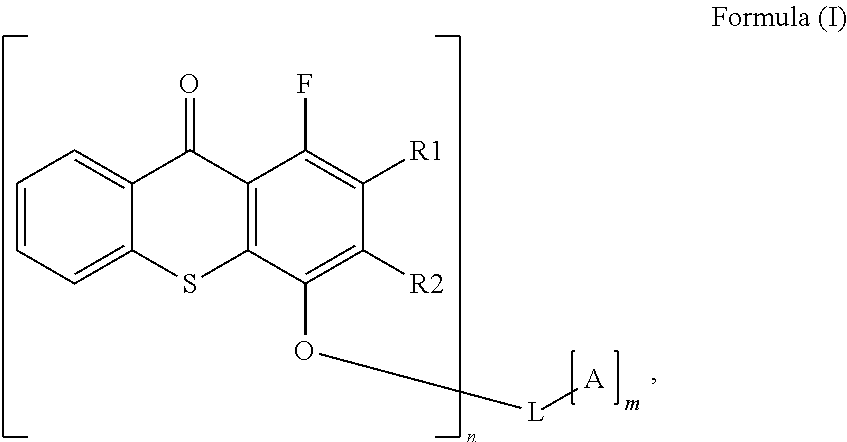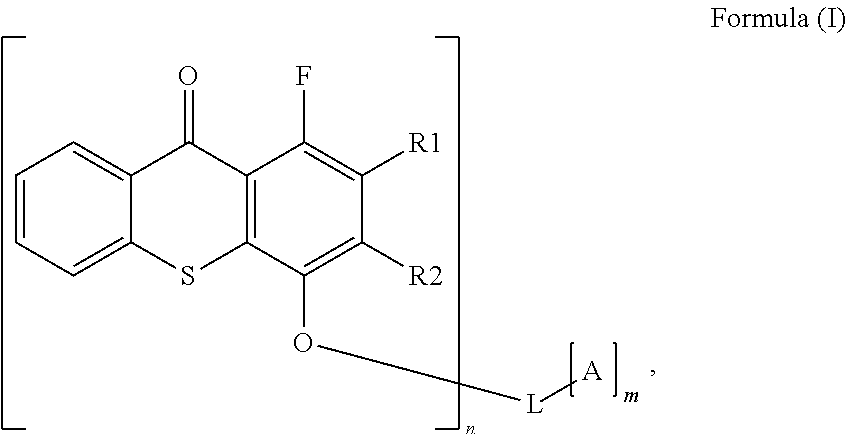Polymerisable photoinitiators for LED curable compositions
a technology of photoinitiators and compositions, applied in the field of photoinitiators, can solve problems such as inacceptable formation of migratable and volatile degradation products
- Summary
- Abstract
- Description
- Claims
- Application Information
AI Technical Summary
Benefits of technology
Problems solved by technology
Method used
Image
Examples
example 1
[0220]This example illustrates how the polymerizable photoinitiators according to a preferred embodiment of the present invention can be prepared.
example 1a
[0221]The polymerizable photoinitiator FITX-1 (acrylic acid 2-{2-[1-(1-fluoro-9-oxo-9H-thioxanthen-4-yloxy)-ethoxy]-ethoxy}-ethyl ester) was prepared according to the following synthesis method:
Step 1: synthesis of 1-fluoro-4-hydroxy-thioxanthen-9-one
[0222]
[0223]Thiosalicylic acid (5.1 g, 0.033 mol) was added in portions to 20 mL sulfuric acid (18M), which causes the temperature to rise to 30° C. At this temperature 4-fluorophenol (11.2 g, 0.10 mol) was added in portions to the suspension. The mixture was heated to 80° C. and stirred for 12 hours. After the reaction, the reaction mixture was poured into ice (150 g). 1-fluoro-4-hydroxy-thioxanthen-9-one precipitated from the medium and was isolated by filtration. The crude 1-fluoro-4-hydroxy-thioxanthen-9-one was dissolved in water at pH=14 using an aqueous solution of potassium hydroxide and stirred for 60 minutes. The mixture was acidified to pH=4 using acetic acid. 1-fluoro-4-hydroxy-thioxanthen-9-one was isolated by filtration an...
example 1b
[0226]The polymerizable photoinitiator FITX-2 (acrylic acid 2-acryloyloxy-3-(1-fluoro-9-oxo-9H-thioxanthen-4-yloxy)-propyl ester) was prepared according to the following synthesis method:
Step 1: synthesis of 4-(2,3-dihydroxy-propoxy)-1-fluoro-thioxanthen-9-one
[0227]
[0228]The reactant 1-fluoro-4-hydroxy-thioxanthen-9-one was prepared as described above in Example 1a. To a suspension of 1-fluoro-4-hydroxy-9H-thioxanthen-9-on (92%) (306 g, 1.14 mol) in acetonitrile (3500 mL), potassium carbonate (464 g, 3.36 mol) was added while stirring vigorously. 3-Chloro-1,2-propanediol (371 g, 3.36 mol) was added drop wise over 30 minutes. The reaction mixture was heated to reflux and allowed to stir for 24 hours. The mixture was filtered and the residue was washed with warm acetonitrile (500 mL) (70° C.). The filtrate was evaporated under reduced pressure. The residual solid was treated with a mixture of methyl-tert-butylether (400 mL) and acetone (40 ml) and stirred for about an hour. The crude ...
PUM
| Property | Measurement | Unit |
|---|---|---|
| viscosity | aaaaa | aaaaa |
| molecular weight | aaaaa | aaaaa |
| molecular weight | aaaaa | aaaaa |
Abstract
Description
Claims
Application Information
 Login to View More
Login to View More - R&D
- Intellectual Property
- Life Sciences
- Materials
- Tech Scout
- Unparalleled Data Quality
- Higher Quality Content
- 60% Fewer Hallucinations
Browse by: Latest US Patents, China's latest patents, Technical Efficacy Thesaurus, Application Domain, Technology Topic, Popular Technical Reports.
© 2025 PatSnap. All rights reserved.Legal|Privacy policy|Modern Slavery Act Transparency Statement|Sitemap|About US| Contact US: help@patsnap.com



